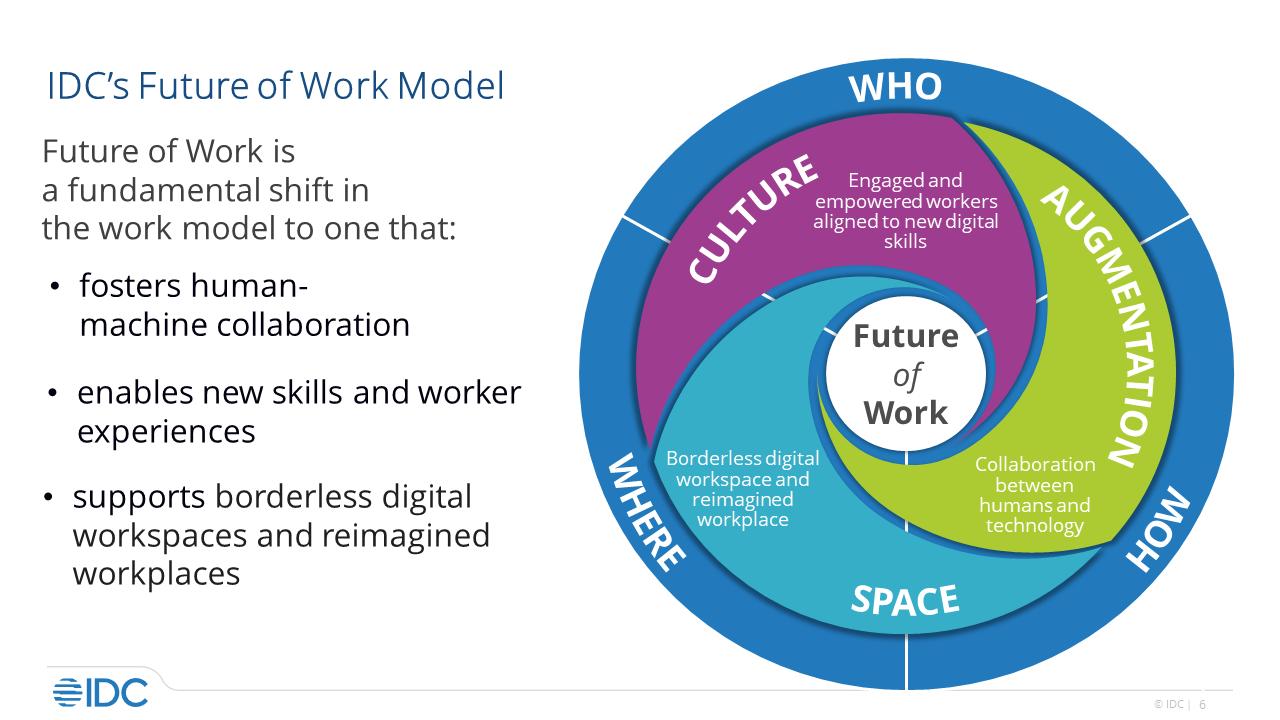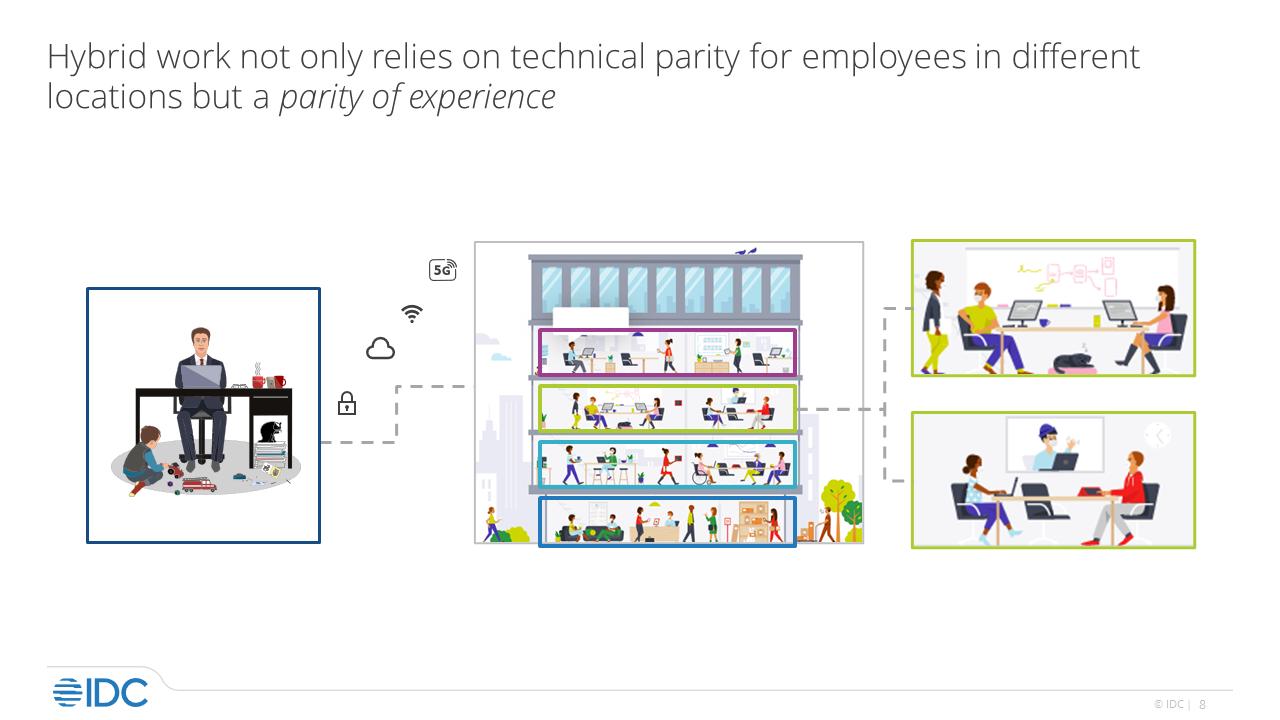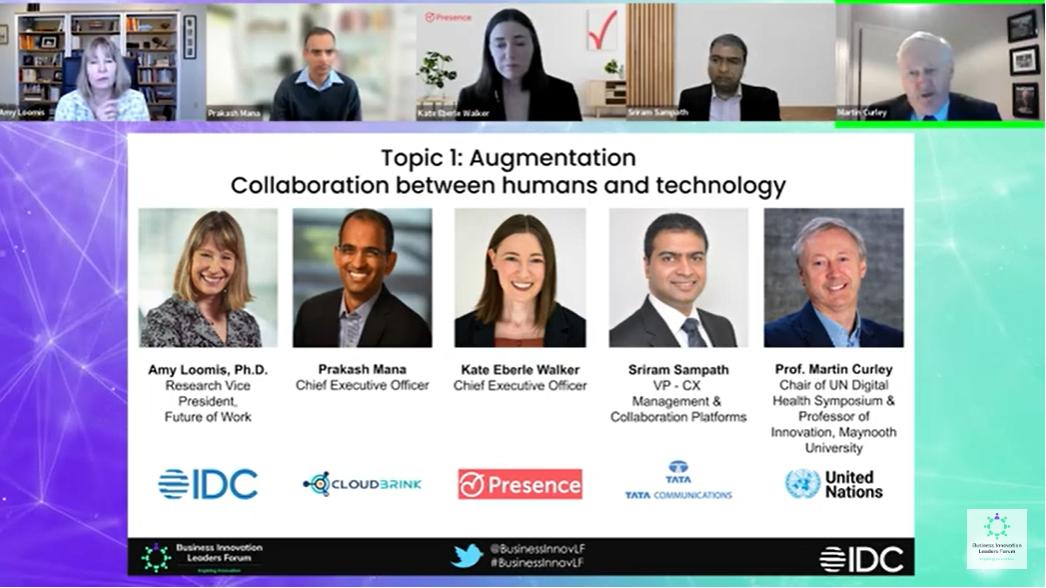
The workplace has changed forever. The rulebook on where and how we work has been ripped up and we are in a new paradigm of productivity where choice and flexibility rule.
Welcome to the world of hybrid work. Its implications for the future were examined in detail during a recent CxO Roundtable debate organised by the Business Innovation Leaders Forum.
The discussion was chaired by Dr Amy Loomis, Research Vice President, Future of Work with independent analyst firm IDC. She was joined by a number of high-profile industry figures to contemplate major workplace trends and the technologies that will be needed to support them. Not least among these was how AI is now being used to augment human efforts in today’s diverse workplace scenarios.
“This could mean anything from Chat GPT to robotic process automation,” said Loomis. “It might involve AR, VR and all sorts of technologies that are facilitating the automation of different tasks across workflows. And that is causing us to change our cultures because so much of what we do is getting automated.”
People, she said, can now engage with each other both physically and virtually in new ways, leading to more cohesive work cultures: “We’re seeing the rise of borderless digital workspaces, environments that facilitate a virtual conversation as well as new ways to access to data and applications,” she commented. “All this means we are not going back to an office or other formal work environment, but forward to a reinvented workplace.”

Work trends and technology investments
Given these changes, as well as economic and skills challenges, climate change and socio-political disruption, what will be the technologies to drive productivity, in 2023 and beyond?
IDC has researched the kind of technology investments that are most likely to endure in a radically altered working paradigm.
“We see that a shift to cloud-based connectivity devices, applications and services is the top thing that people are investing in for the future,” Loomis revealed. “And people are investing in how to make hybrid models work. The momentum on digital workspaces is tied into cloud infrastructure, as well as to employee experience which also drives customer experience. We will see automation of repetitive tasks and workflows, sometimes to compensate for a lack of people to do some of those repetitive jobs.”
Essential to hybrid work is, she said, ensuring that employees can all enjoy a parity of experience: “No matter where you are or on what device, you need to be able to engage with people, applications and data to get work done. You need to open up a democratization of access so that people who are not physically side by side can feel just as included socially and professionally as those who are in the same room.“

Supporting hybrid workers
It is not, of course, just a matter of applying tech. Hybrid working success is about a human investment in skills around collaboration, communication and creativity across dispersed digital and physical environments. It necessitates building a culture of trust, relying on employees to keep personal resources and corporate resources and client data secure and private.
“This is one of the main concerns around building hybrid work culture, along with trusting employees to complete their work,” said Loomis. “We need to focus on those things and in so doing drive productivity. Employees are more motivated to stay in companies when quickly on boarded and supported. Hybrid work involves not only in an investment in digital, it also in requires an investment in organizational approaches. It’s about reimagining facilities and locations, determining who’s going to work where and how.”
To broaden the conversation, Loomis involved a panel of influential industry names. Sriram Sampath is Vice President – CX Management & Collaboration Platforms with Tata Communications. “When I look at the technologies that we have adopted recently, some are new and some have been around for a long time,” he reflected. “Take NLP, for example. Speech recognition has been with us for several years, but adoption was limited. Things have changed a lot in the last couple of years.
Enterprises have modified the way they are looking at technologies like this to augment what they do from a business perspective. That might be a chat application when you’re logging onto a website. The way that these technologies have been adopted really helps employees, and customers.”
Kate Eberle Walker is CEO of Presence, a provider of teletherapy services to children in schools with a network of over 2,000 clinicians, psychologists and speech therapists. “Many of these work from home and connect with children who are in schools to deliver therapy,” she said. “We are thinking all the time about technology and where we can use it, not only to make a human connection and deliver services, but to augment what those therapists do. That might be taking paperwork or admin away so that they can focus their time and effort on engagement and interaction with the children. I think with AI developments getting stronger and stronger, there’s going to be increasing opportunity to use technology to take more of a load off.”
Prakash Mana is co-founder and CEO of Cloudbrink, a SaaS service that delivers an office experience to the modern remote and hybrid workforce. He notes how we have unshackled ourselves from classic desk-based work and opened up more creative ways of boosting productivity, and enjoying work as well as life, with technology making it all possible.
“Digital technologies have been focused on providing best performance for people inside the office,” he reflected. “Enterprises have spent billions of dollars committing to this. Now we’re seeing everyone is demanding the same lightning-fast, office-like experience, with invisible levels of security, wherever they go.”
Technology can, of course cut both ways with hybrid work. Eberle Walker of Presence found that collaboration was central to a remote work environment, and at first technology appeared to be the solution: “We found we had to redefine how we worked together and how we collaborated,” she recalled. “The first organizational reaction to remote work was to constantly get together on video conferences, and it led to a very meeting heavy culture. So we had to launch meeting reduction initiatives to try to get some time back as we found we were losing productivity. Why not have a two-minute discussion instead of a 20 minute meeting? We shifted some of our interaction to Google Docs.”
Sampath of Tata Communications has seen customers buy a lot of technology to facilitate workers which is then not fully used: “You pay so much for 20 features, and barely use two or three of them,” he claimed. “It’s important for employees to be made aware that there are so many ways in which their productivity could improve. When you empower employees with the right tools and platforms, and train them in how to use that, you empower them with all they need to handle their jobs wherever they are located.”
Bringing a new angle to the debate was Professor Martin Curley of Maynooth University, also Chair of the Science Summit of the United Nation’s (UNGA) Digital Health Symposium. He sees healthcare as on the frontline of the possibilities of technology and how it can transform the work environment, and has also seen how tensions can arise: “I’ve seen resistance to new ideas, old power versus new power,” he said. “I’ve worked in the Irish health service where non-clinical administrators are very removed from what’s happening at the coalface and quite resistant to change.”
Change can be disruptive whether we like it or not, argued Mana of Cloudbrink: “We’re living through a once in a generation shift where when how we work is fundamentally changing,” he noted. “A global statistic I read recently shows that only 9% of people want to go back to office full time which has a massive implication for both physical as well as digital infrastructure. One thing that is consistent across the board, that everybody agrees on, is that our future is all about getting the best out of our most important asset, which is people. And we need technology to help us perform at our best regardless of where wherever we are.”
Eberle Walker of Presence agreed that people are key: “We have a majority female workforce and many of our primary caregivers are working mothers,” she said. “There is research showing that women, even more so than men, have a preference for flexible work schedules and remote work. It’s a big part of how we’ve built our network, by offering remote paths and flexible schedules wherever we can. What we want out of our physical workspaces has been really interesting for me over the past year. We have seen that there are different things that people want out of their office space.”
Curley of the United Nation’s (UNGA) Digital Health Symposium says flexibility can apply inside and outside of the private sector: “We bring sick people into hospitals, which are nasty places where they can acquire infections,” he said. “That’s why in some cases the point of delivery has been shifted from the hospital to the home. We call this stay left, shift left, 10x as an overarching strategy. It means a patient gets treated and doctors and nurses have much less of a workload. There’s a greenhouse gas saving too. It’s a win win solution. Moving forward I think many industries will be totally reimagined and that we can create a whole new kind of workplace with better service and better results.”

Analyst Chair: Amy Loomis Ph.D. Research Vice President, Future of Work, IDC
Prakash Mana, Co-founder & CEO, Cloudbrink
Kate Eberle Walker, CEO, Presence
Prof: Martin Curley, Maynooth University & Chair of the Science Summit, United Nations General Assembly (UNGA) Digital Health Symposium
Sriram Sampath, Vice President – CX Management & Collaboration Platforms, Tata Communications
Webcast: https://www.youtube.com/watch?v=zOpVeBpjL40 / https://www.businessinnovationleadersforum.org/public/events/hybrid-workplace/






